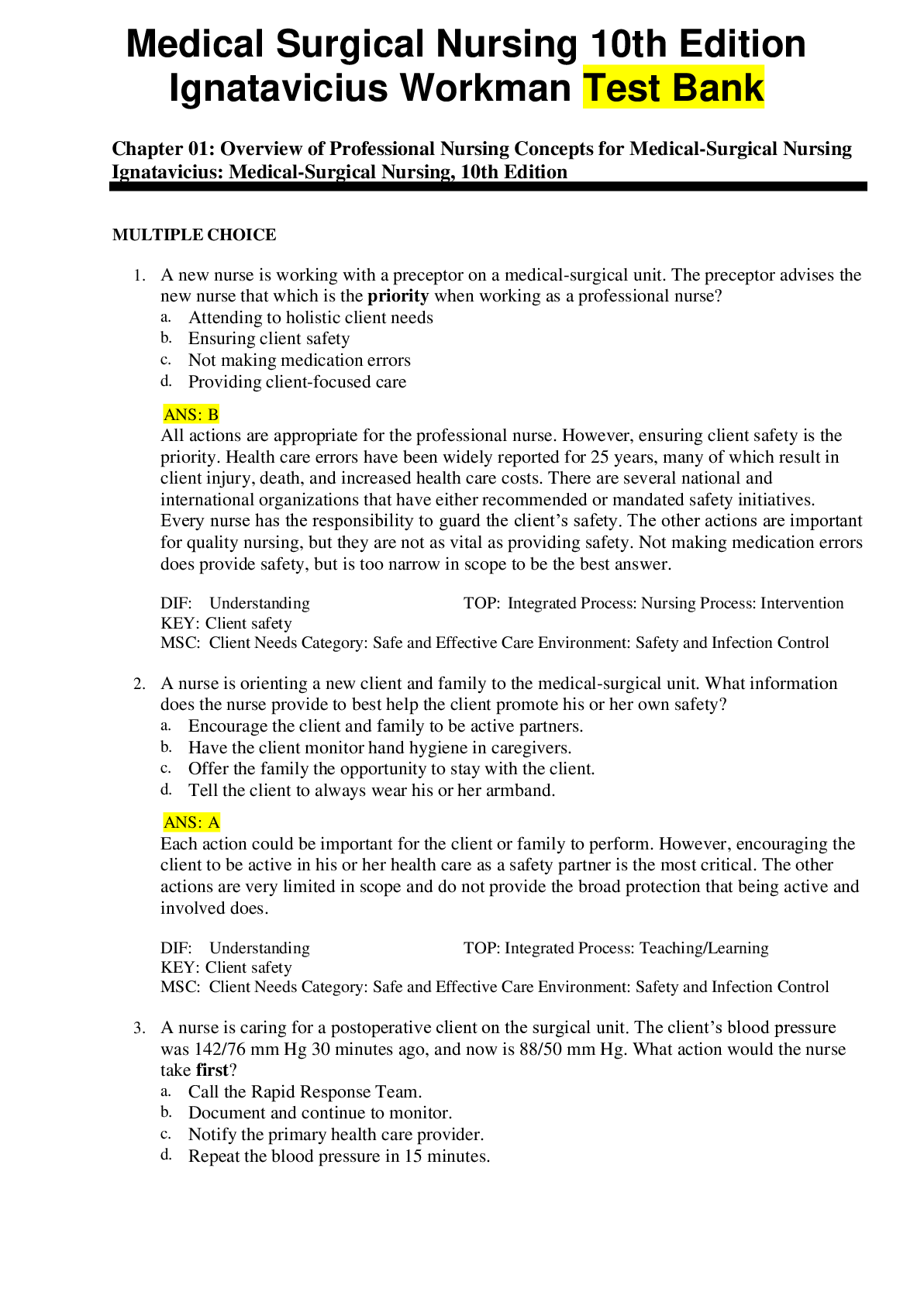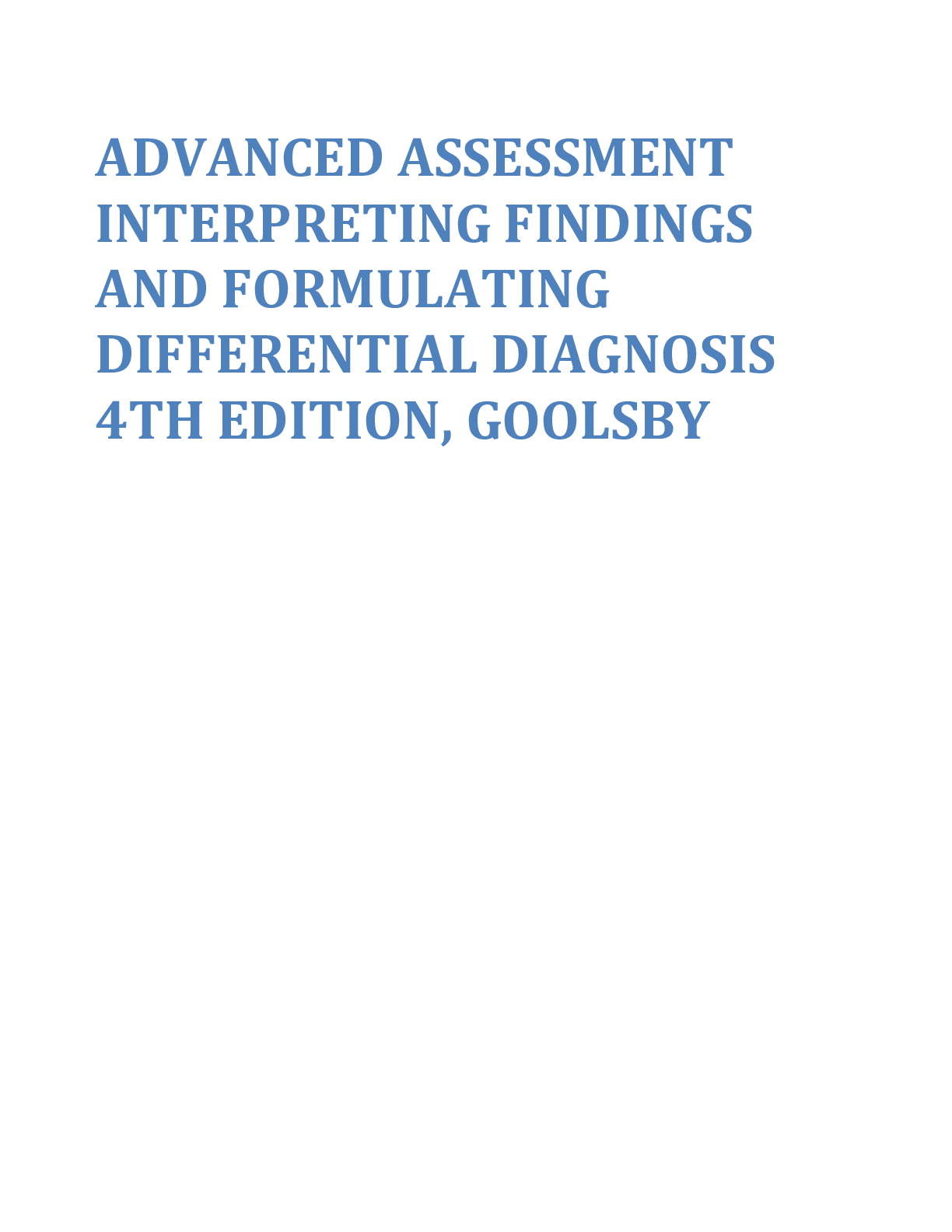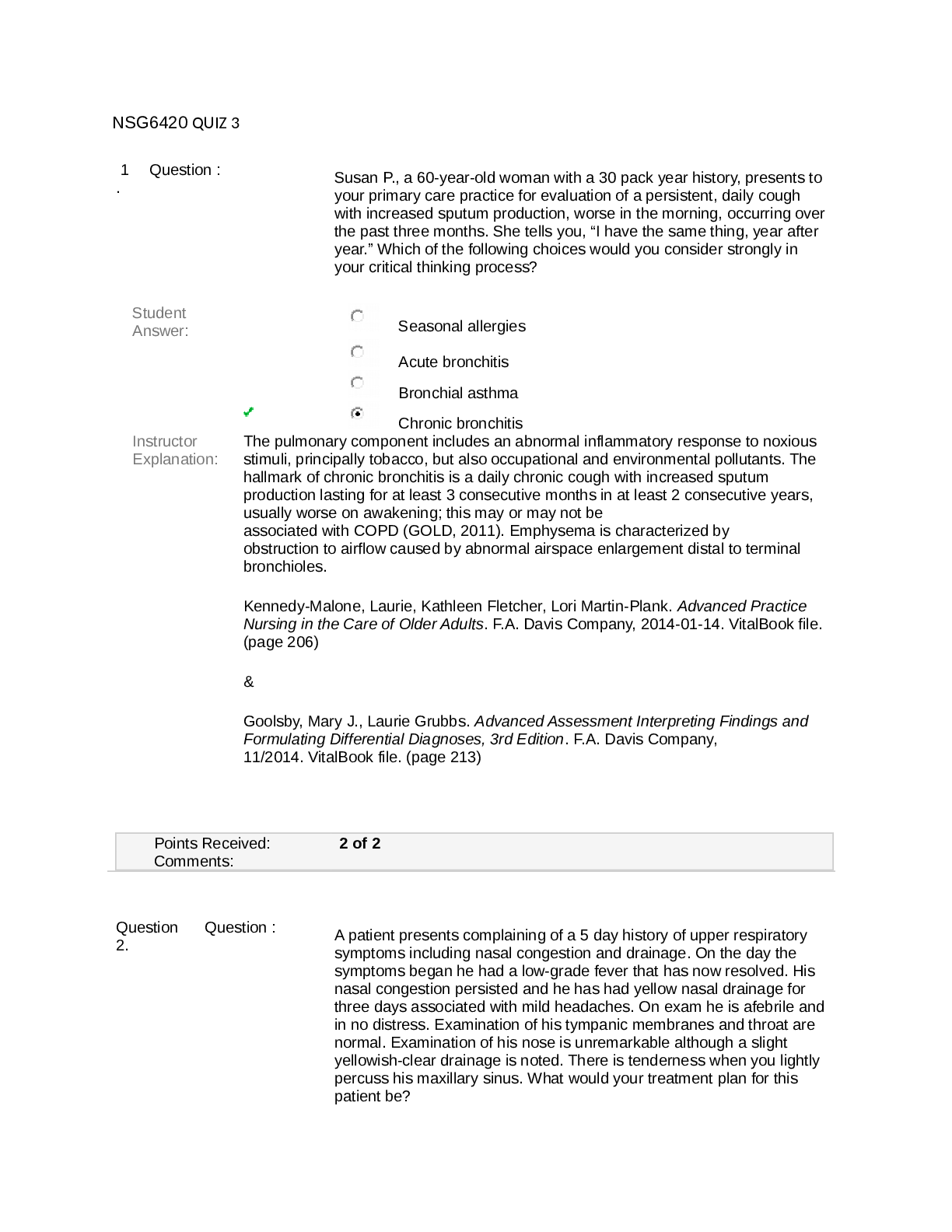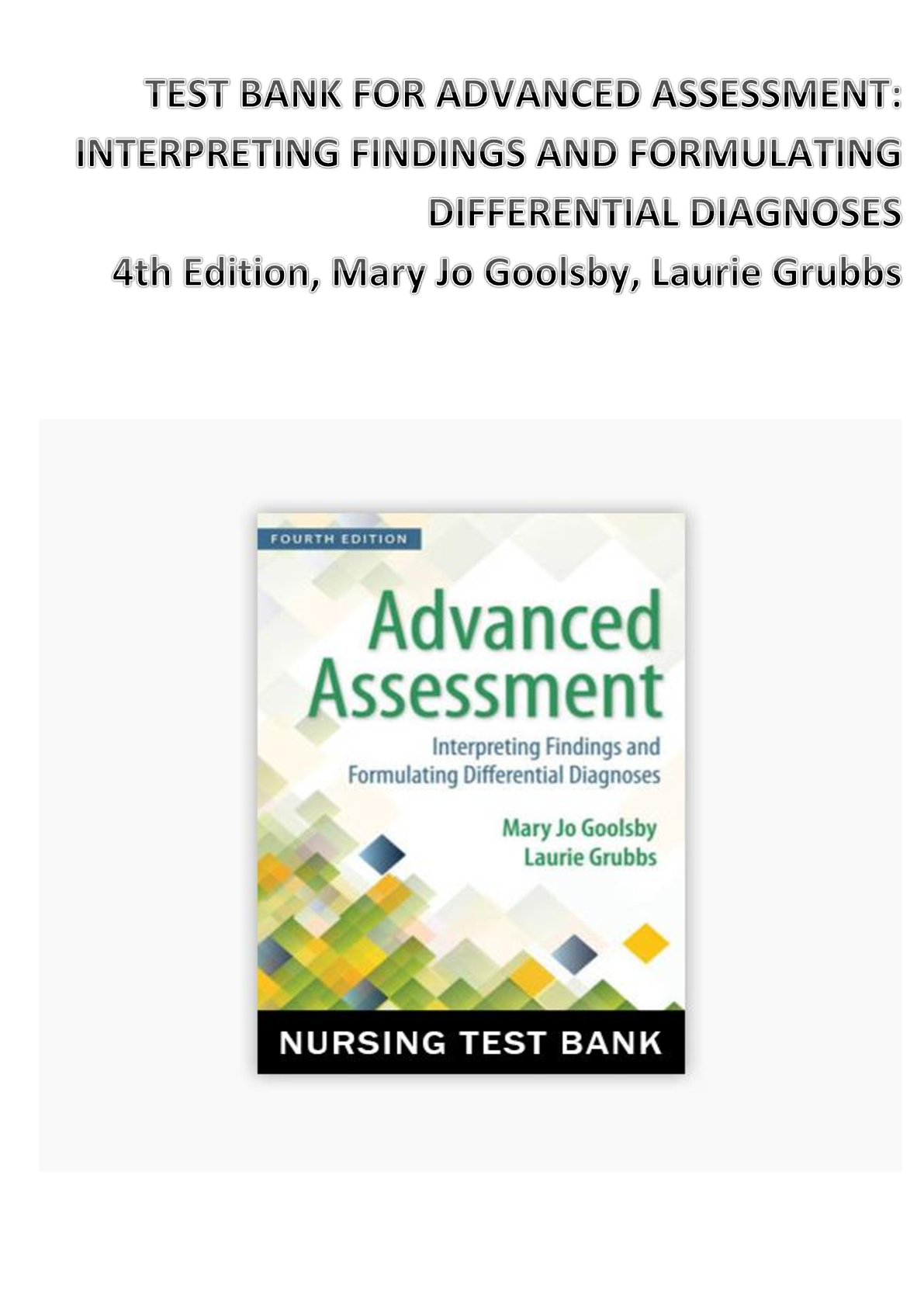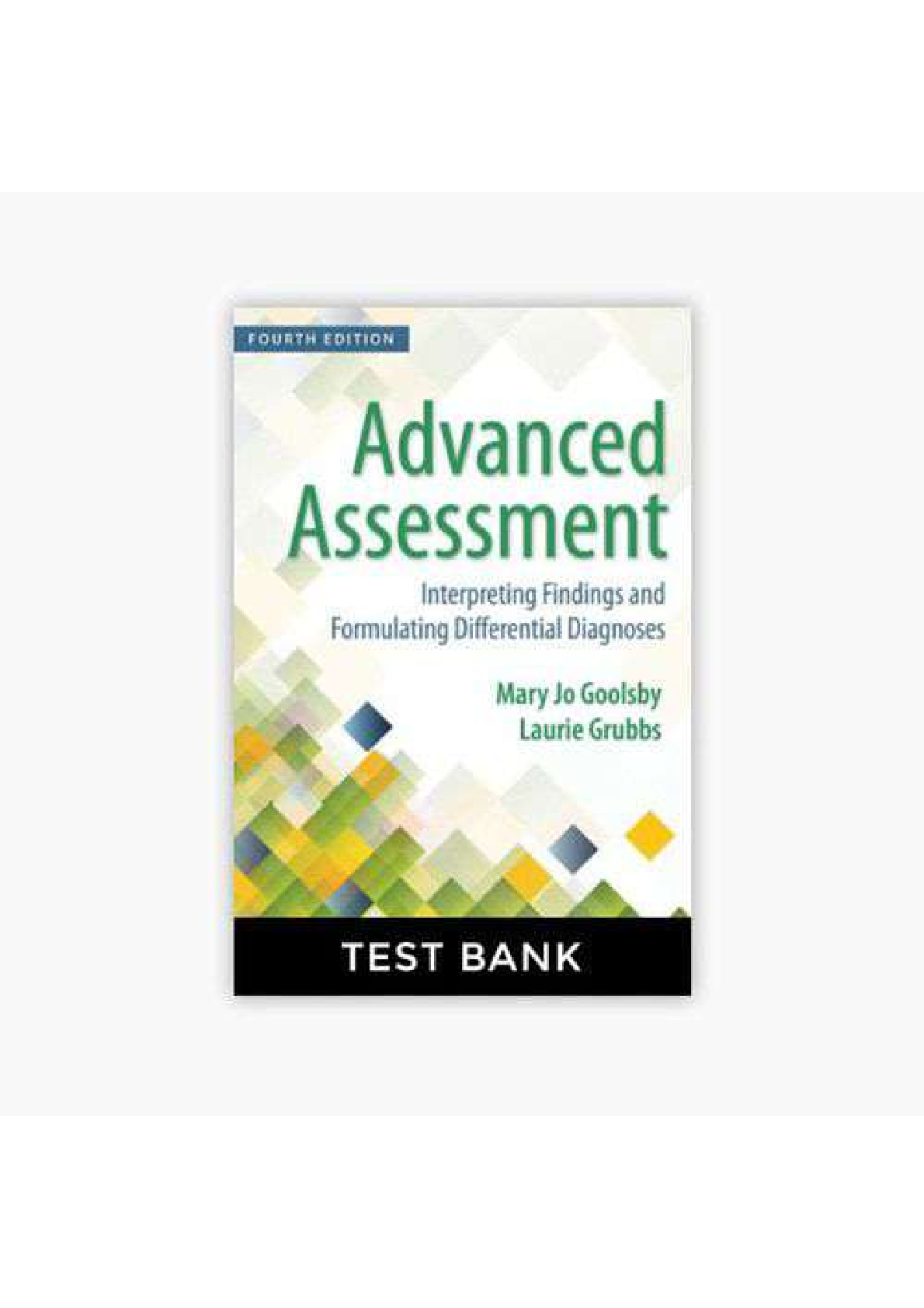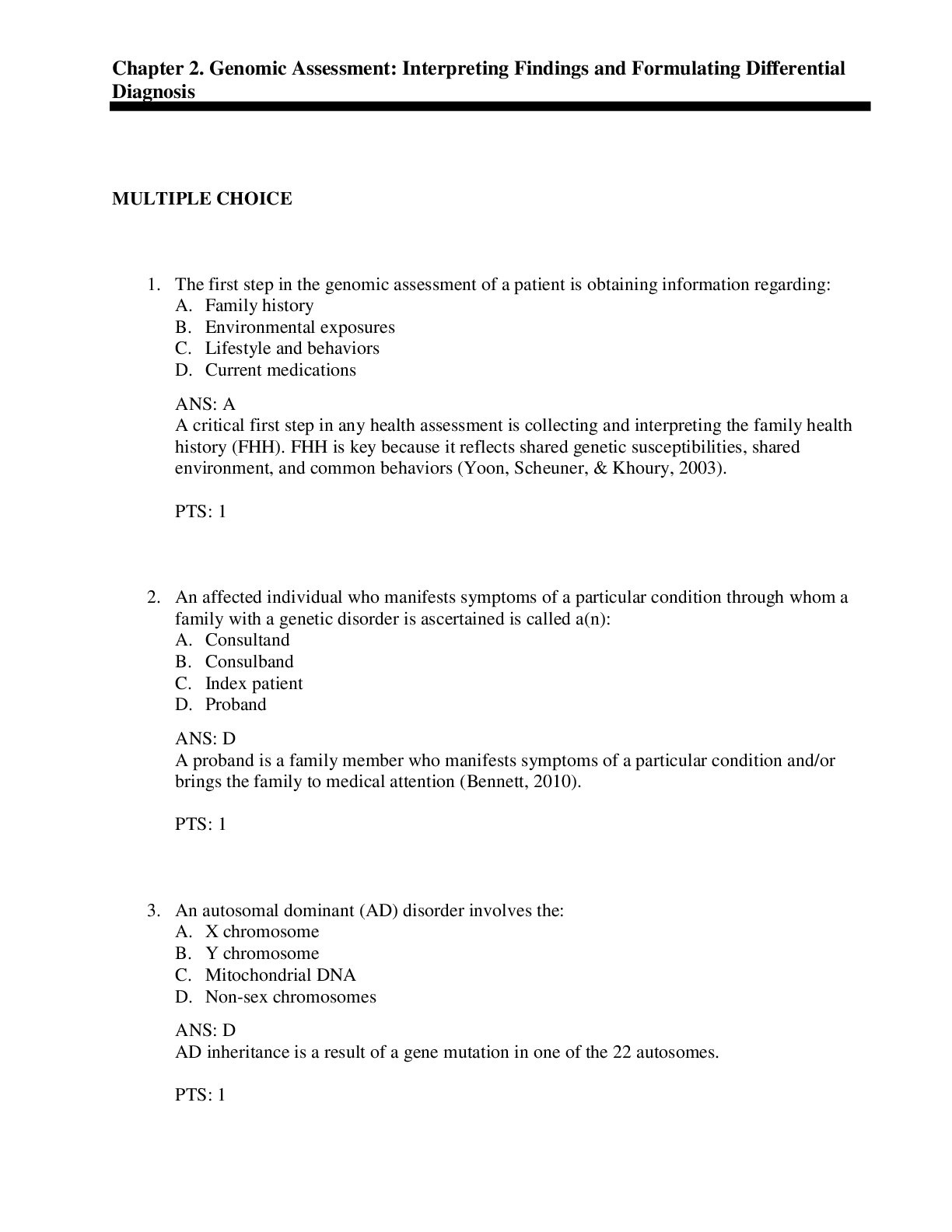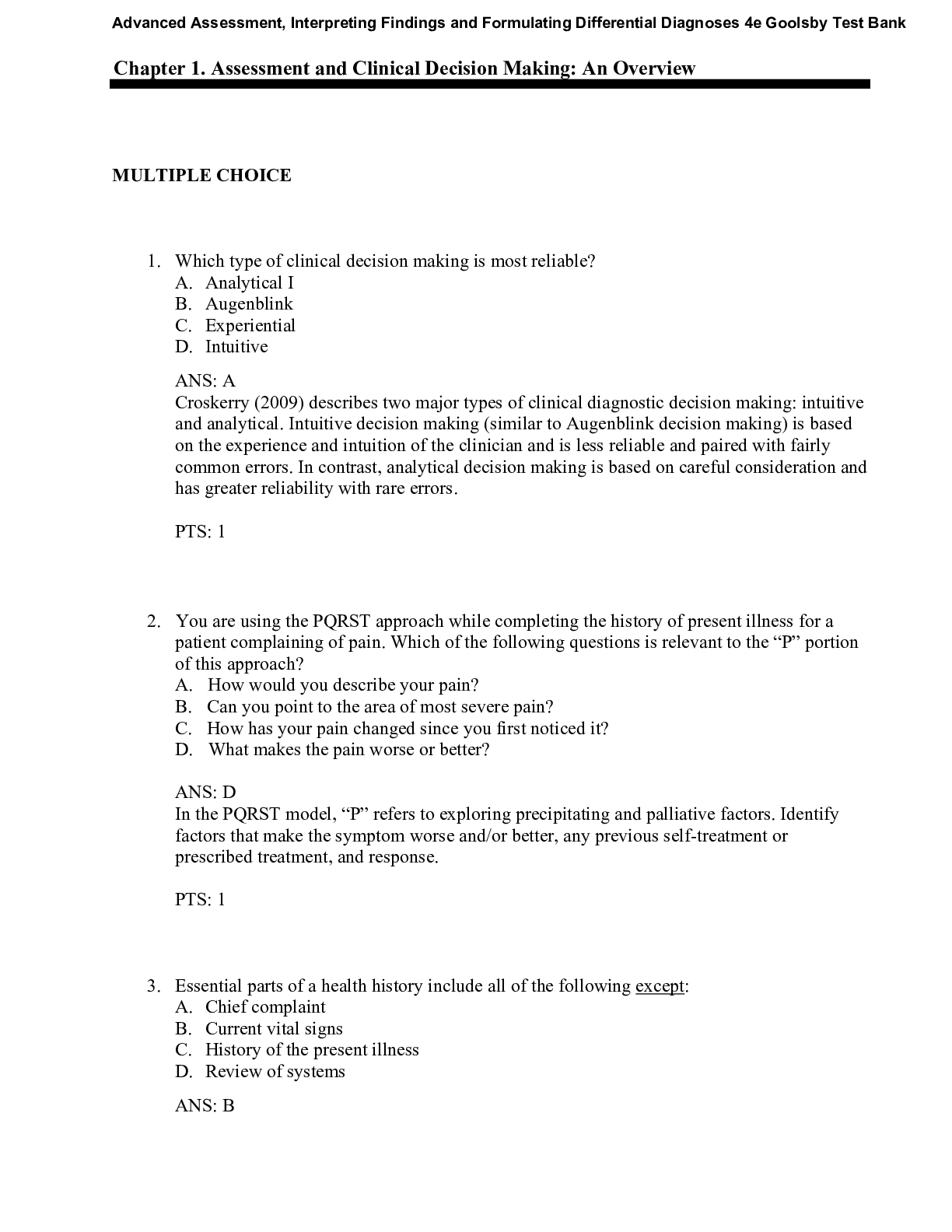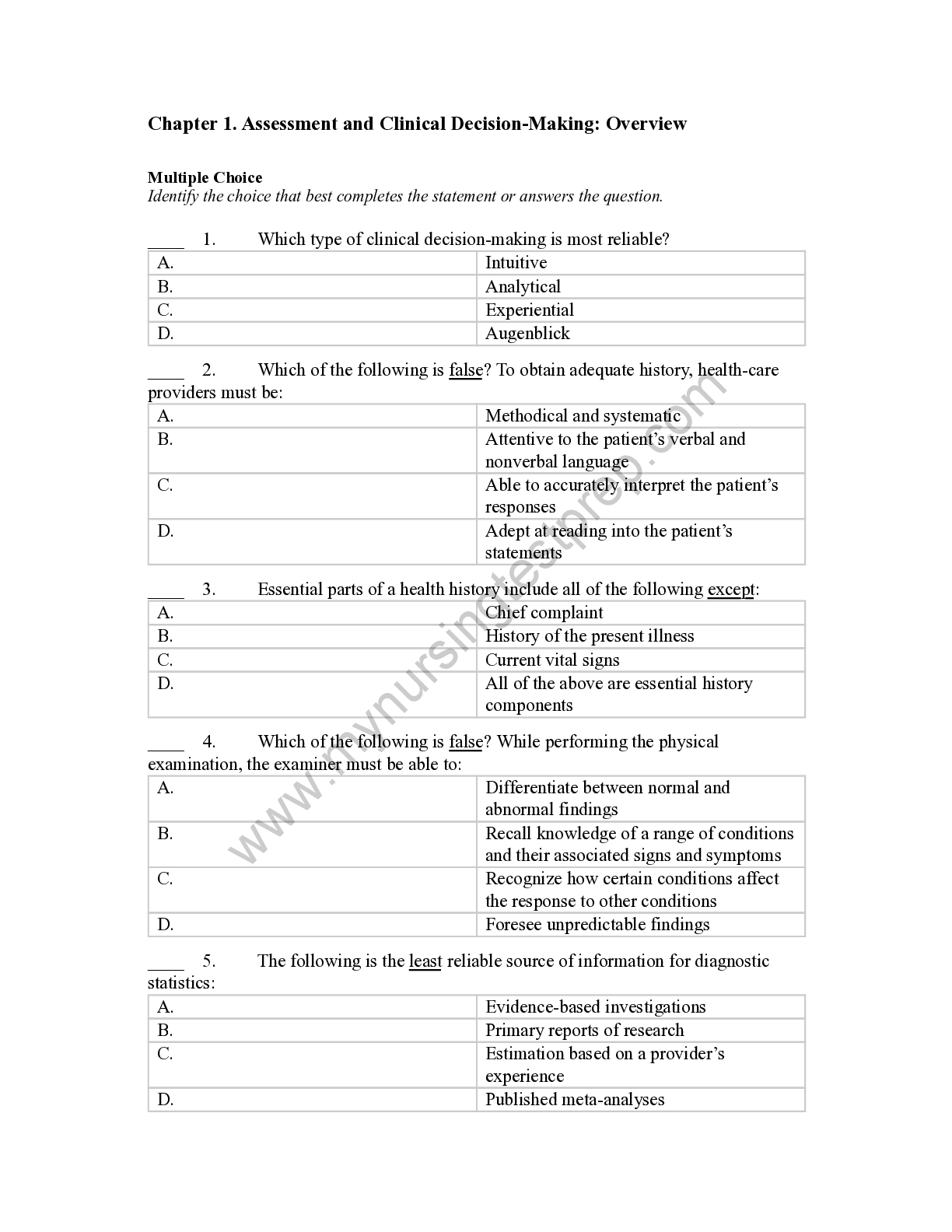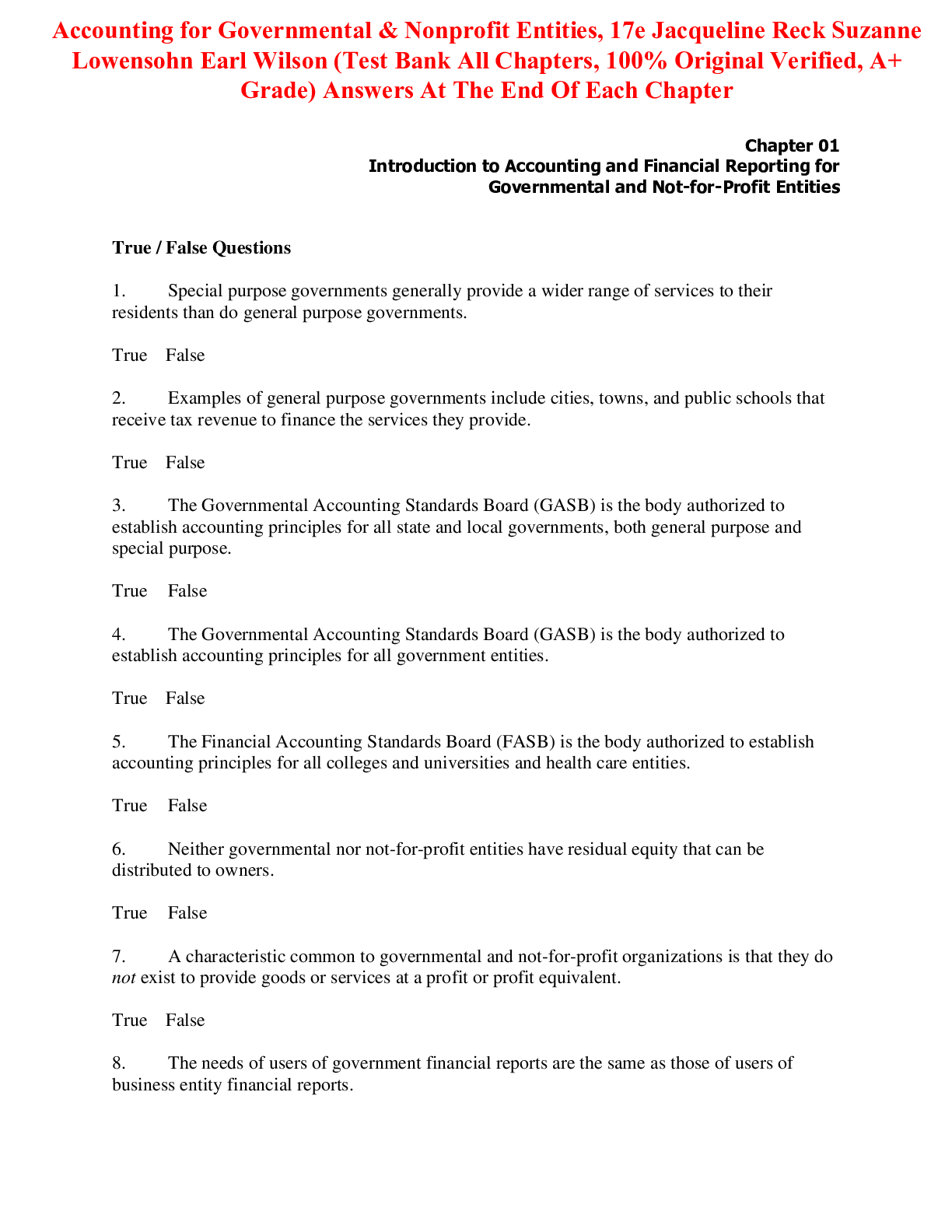*NURSING > TEST BANK > Test Bank for Advanced Assessment Interpreting Findings and Formulating Differential Diagnoses 5 ED (All)
Test Bank for Advanced Assessment Interpreting Findings and Formulating Differential Diagnoses 5 ED by Laurie Goolsby, Mary Jo; Grubbs
Document Content and Description Below
Chapter 1. Assessment and Clinical Decision-Making: Overview Chapter 2. An Overview of Genetic Assessment Chapter 3. Skin Chapter 4. Head, Face, and Neck Chapter 5. The Eye Chapter 6. Ear, N... ose, Mouth, and Throat Chapter 7. Cardiac and Peripheral Vascular Systems Chapter 8. Respiratory System Chapter 9. Breasts Chapter 10. Abdomen Chapter 11. Genitourinary System Chapter 12. Male Reproductive System Chapter 13. Female Reproductive System Chapter 14. Musculoskeletal System Chapter 15. Neurological System Chapter 16. Nonspecific Complaints Chapter 17. Psychiatric Mental Health Chapter 18. Pediatric Patients Chapter 19. Pregnant Patients Chapter 20. Older Patients Differential Studies Genetic testing for pharmacologic prescriptions for psychiatric mental health conditions Diagnosis algorithm decision trees designed to help nurses assess and diagnose conditions such as chronic sore throat, chronic insomnia, and more Chapter 1. Assessment and Clinical Decision-Making: Overview Answer Section MULTIPLE CHOICE 1. ANS: B Croskerry (2009) describes two major types of clinical diagnostic decision-making: intuitive and analytical. Intuitive decision-making (similar to Augenblink decision-making) is based on the experience and intuition of the clinician and is less reliable and paired with fairly common errors. In contrast, analytical decision-making is based on careful consideration and has greater reliability with rare errors. PTS: 1 2. ANS: D To obtain adequate history, providers must be well organized, attentive to the patient’s verbal and nonverbal language, and able to accurately interpret the patient’s responses to questions. Rather than reading into the patient’s statements, they clarify any areas of uncertainty. PTS: 1 3. ANS: C Vital signs are part of the physical examination portion of patient assessment, not part of the health history. PTS: 1 4. ANS: D While performing the physical examination, the examiner must be able to differentiate between normal and abnormal findings, recall knowledge of a range of conditions, including their associated signs and symptoms, recognize how certain conditions affect the response to other conditions, and distinguish the relevance of varied abnormal findings. PTS: 1 5. ANS: C Sources for diagnostic statistics include textbooks, primary reports of research, and published meta-analyses. Another source of statistics, the one that has been most widely used and available for application to the reasoning process, is the estimation based on a provider’s experience, although these are rarely accurate. Over the past decade, the availability of evidence on which to base clinical reasoning is improving, and there is an increasing expectation that clinical reasoning be based on scientific evidence. Evidence-based statistics are also increasingly being used to develop resources to facilitate clinical decision-making. PTS: 1 6. ANS: D To assist in clinical decision-making, a number of evidence-based resources have been developed to assist the clinician. Resources, such as algorithms and clinical practice guidelines, assist in clinical reasoning when properly applied. PTS: 1 7. ANS: A The sensitivity of a diagnostic study is the percentage of individuals with the target condition who show an abnormal, or positive, result. A high sensitivity indicates that a greater percentage of persons with the given condition will have an abnormal result. PTS: 1 8. ANS: B The specificity of a diagnostic study is the percentage of normal, healthy individuals who have a normal result. The greater the specificity, the greater the percentage of individuals who will have negative, or normal, results if they do not have the target condition. PTS: 1 9. ANS: A The likelihood ratio is the probability that a positive test result will be associated with a person who has the target condition and a negative result will be associated with a healthy person. A likelihood ratio above 1 indicates that a positive result is associated with the disease; a likelihood ratio less than 1 indicates that a negative result is associated with an absence of the disease. PTS: 1 10. ANS: B Clinical decision (or prediction) rules provide another support for clinical reasoning. Clinical decision rules are evidence-based resources that provide probabilistic statements regarding the likelihood that a condition exists if certain variables are met with regard to the prognosis of patients with specific findings. Decision rules use mathematical models and are specific to certain situations, settings, and/or patient characteristics. PTS: 1 Chapter 1. Assessment and Clinical Decision-Making: Overview Multiple Choice Identify the choice that best completes the statement or answers the question. ____ 1. Which type of clinical decision-making is most reliable? A. Intuitive B. Analytical C. Experiential D. Augenblick ____ 2. Which of the following is false? To obtain adequate history, health-care providers must be: A. Methodical and systematic B. Attentive to the patient’s verbal and nonverbal language C. Able to accurately interpret the patient’s responses D. Adept at reading into the patient’s statements ____ 3. Essential parts of a health history include all of the following except: A. Chief complaint B. History of the present illness C. Current vital signs D. All of the above are essential history components ____ 4. Which of the following is false? While performing the physical examination, the examiner must be able to: A. Differentiate between normal and abnormal findings B. Recall knowledge of a range of conditions and their associated signs and symptoms C. Recognize how certain conditions affect the response to other conditions D. Foresee unpredictable findings ____ 5. The following is the least reliable source of information for diagnostic statistics: A. Evidence-based investigations B. Primary reports of research C. Estimation based on a provider’s experience D. Published meta-analyses ____ 6. The following can be used to assist in sound clinical decision-making: A. Algorithm published in a peer-reviewed journal article B. Clinical practice guidelines C. Evidence-based research D. All of the above ____ 7. If a diagnostic study has high sensitivity, this indicates a: A. High percentage of persons with the given condition will have an abnormal result B. Low percentage of persons with the given condition will have an abnormal result C. Low likelihood of normal result in persons without a given condition D. None of the above ____ 8. If a diagnostic study has high specificity, this indicates a: A. Low percentage of healthy individuals will show a normal result B. High percentage of healthy individuals will show a normal result C. High percentage of individuals with a disorder will show a normal result D. Low percentage of individuals with a disorder will show an abnormal result ____ 9. A likelihood ratio above 1 indicates that a diagnostic test showing a: A. Positive result is strongly associated with the disease B. Negative result is strongly associated with absence of the disease C. Positive result is weakly associated with the disease D. Negative result is weakly associated with absence of the disease ____ 10. Which of the following clinical reasoning tools is defined as evidence-based resource based on mathematical modeling to express the likelihood of a condition in select situations, settings, and/or patients? A. Clinical practice guideline B. Clinical decision rule C. Clinical algorithm D. Clinical recommendation [Show More]
Last updated: 9 months ago
Preview 1 out of 259 pages

Reviews( 2 )

by Tracy Hepner · 9 months ago
Thanks. give us more recommendations. by Prof.Exams. 9 months ago

by Prof.Exams · 9 months ago
Document information
Connected school, study & course
About the document
Uploaded On
Feb 21, 2023
Number of pages
259
Written in
Additional information
This document has been written for:
Uploaded
Feb 21, 2023
Downloads
1
Views
73


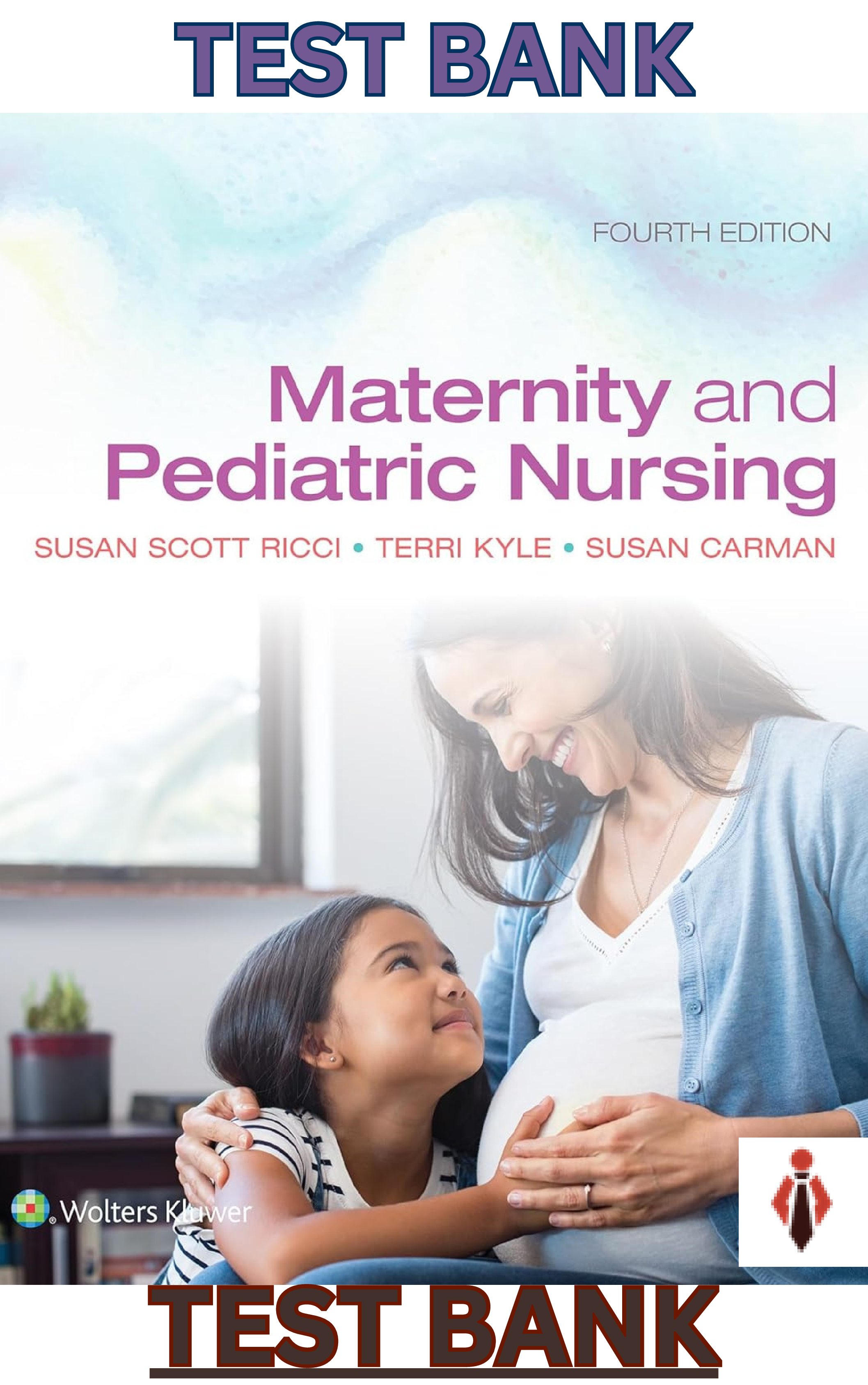
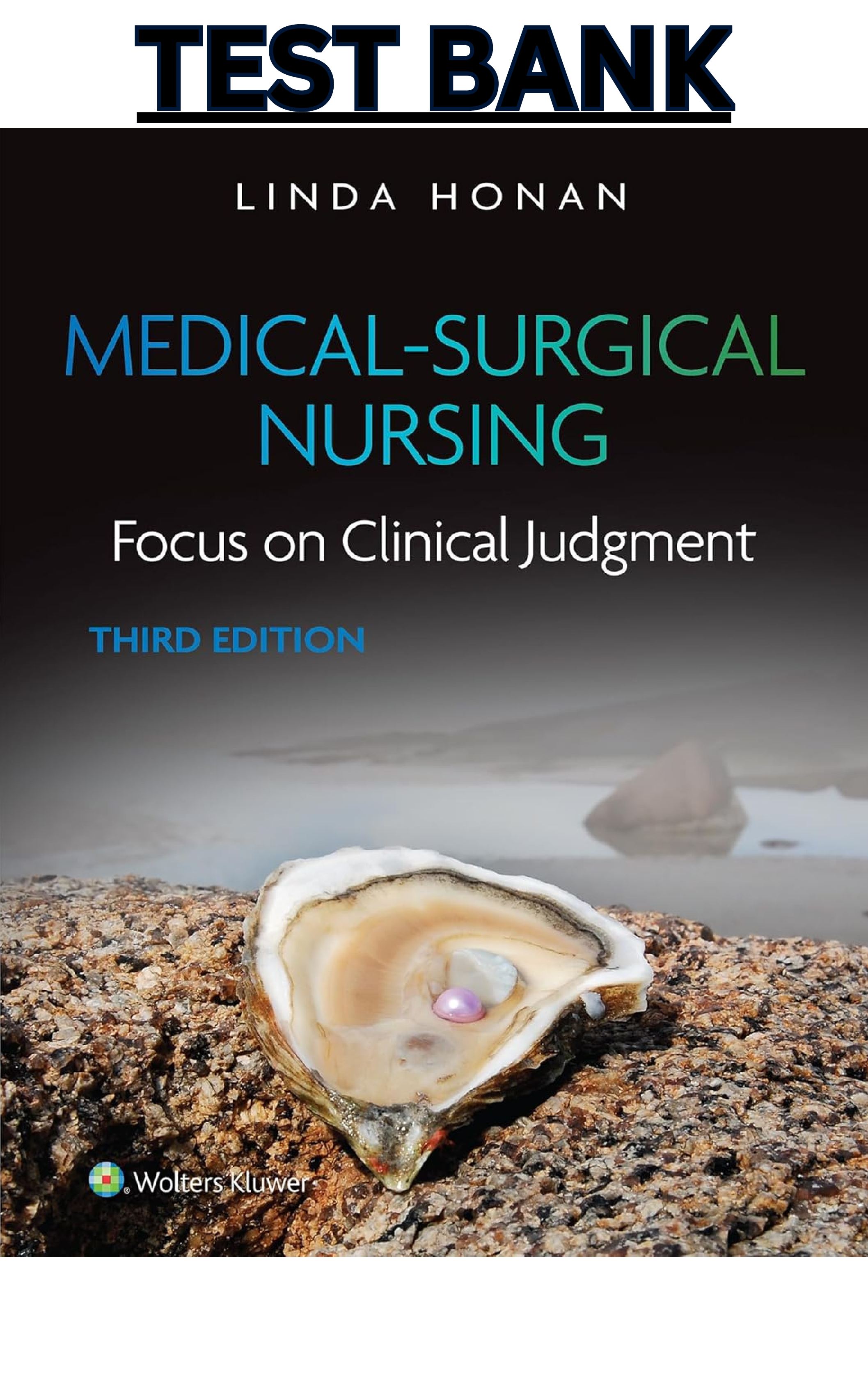
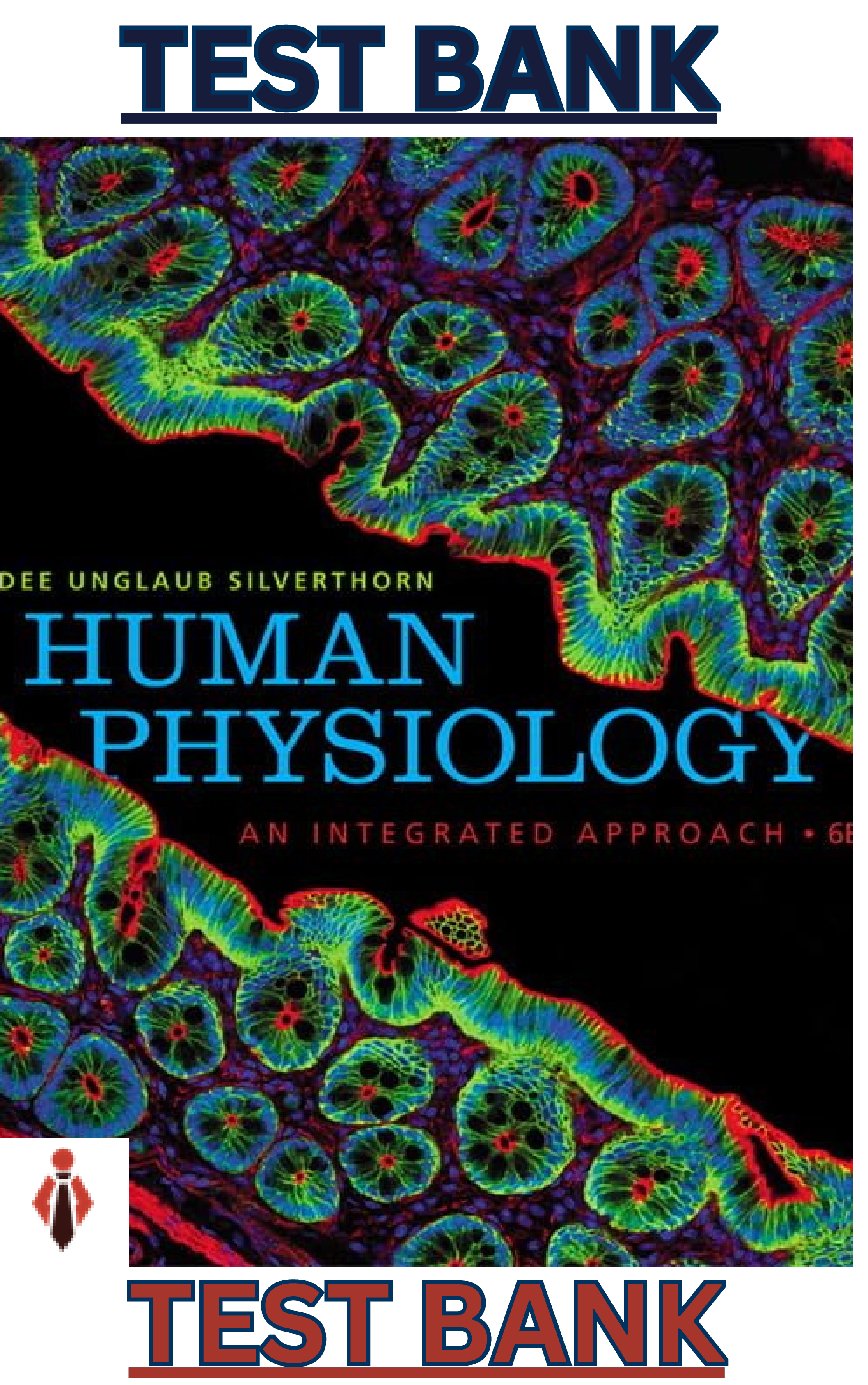

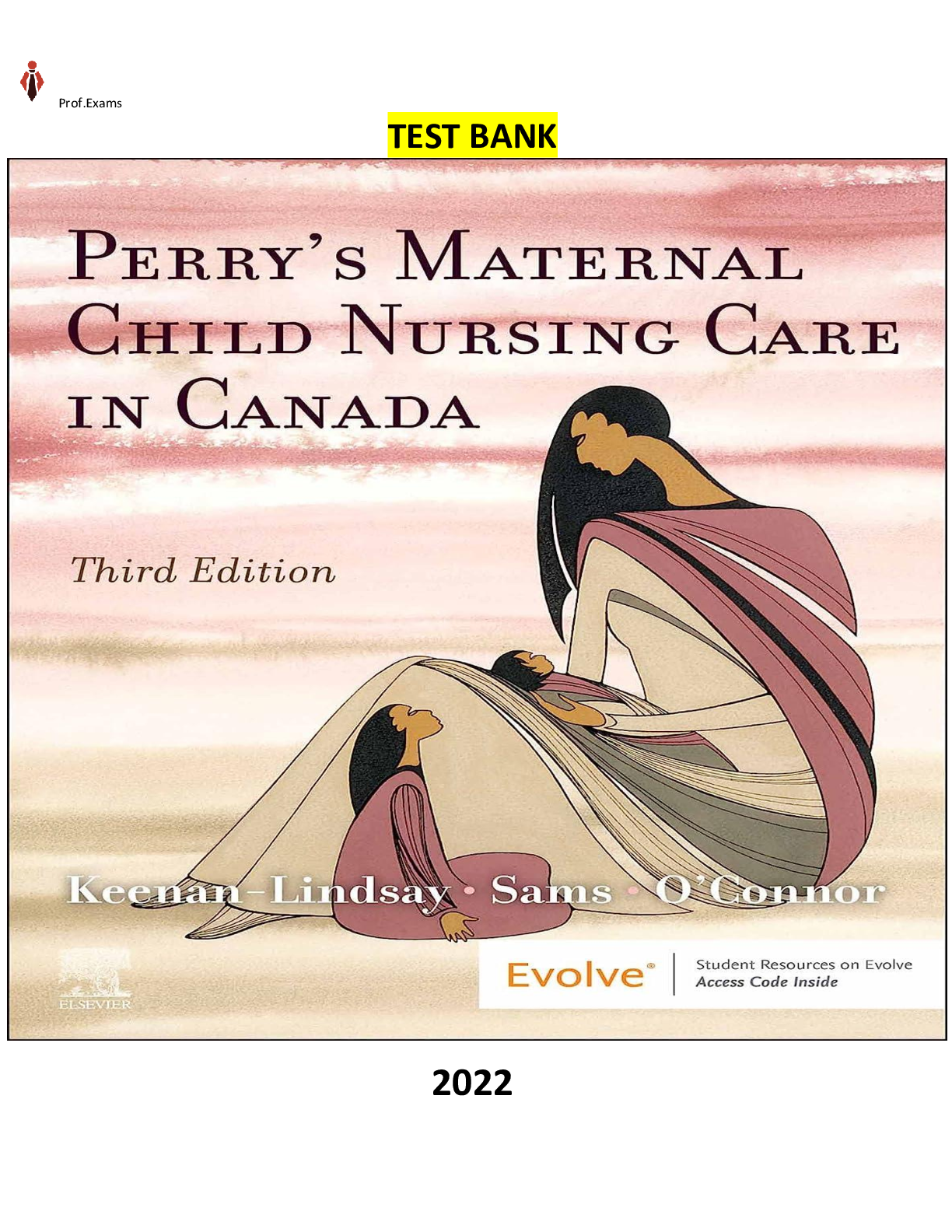
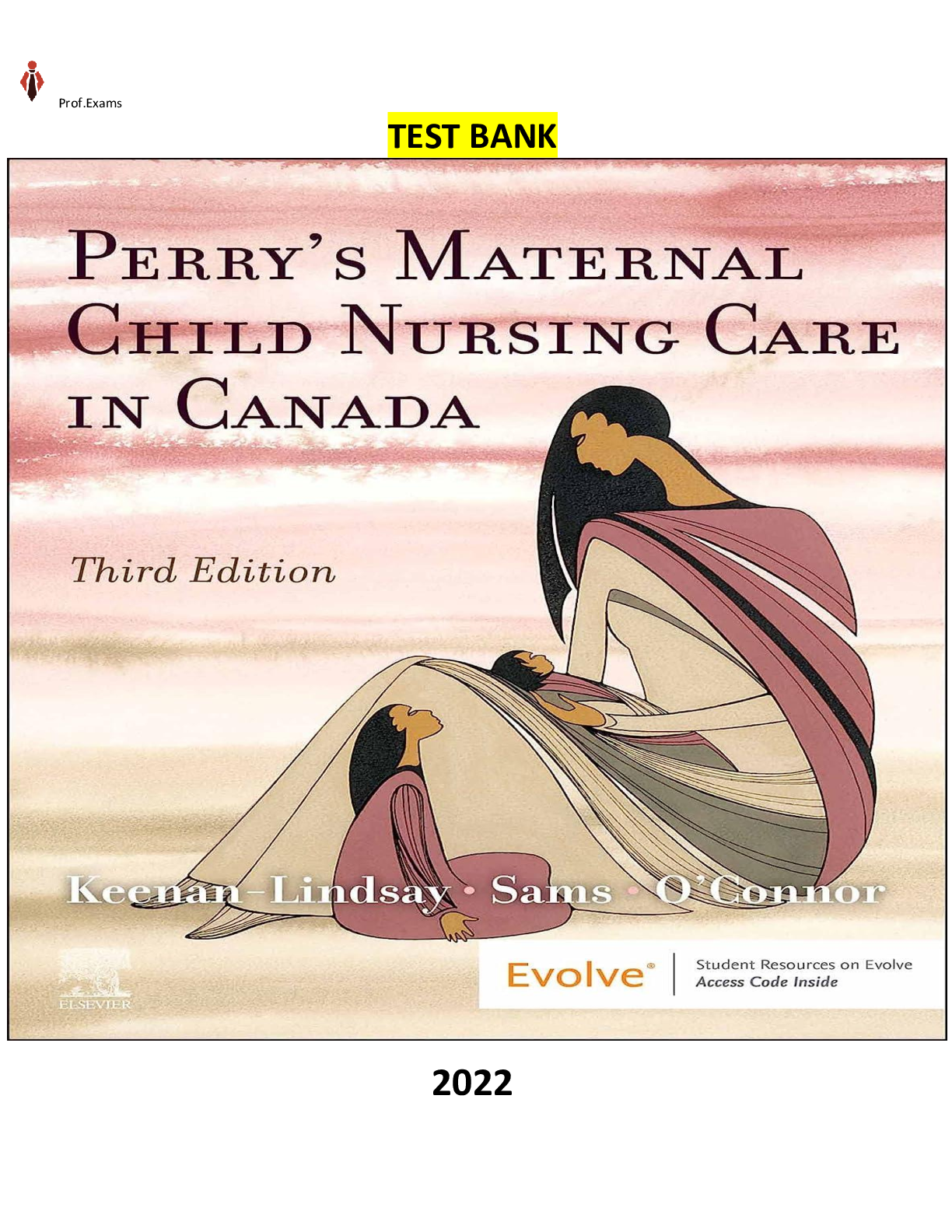
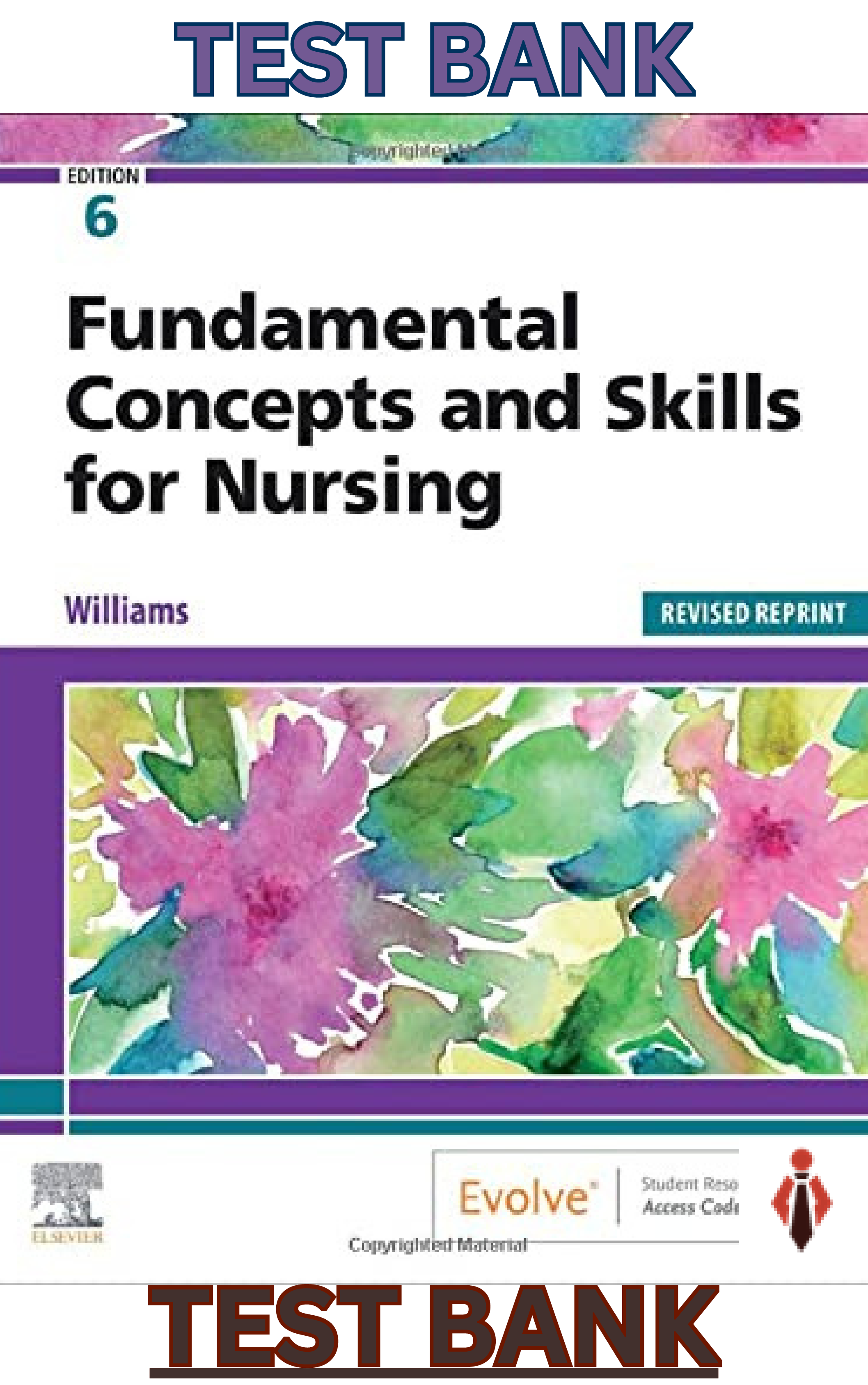

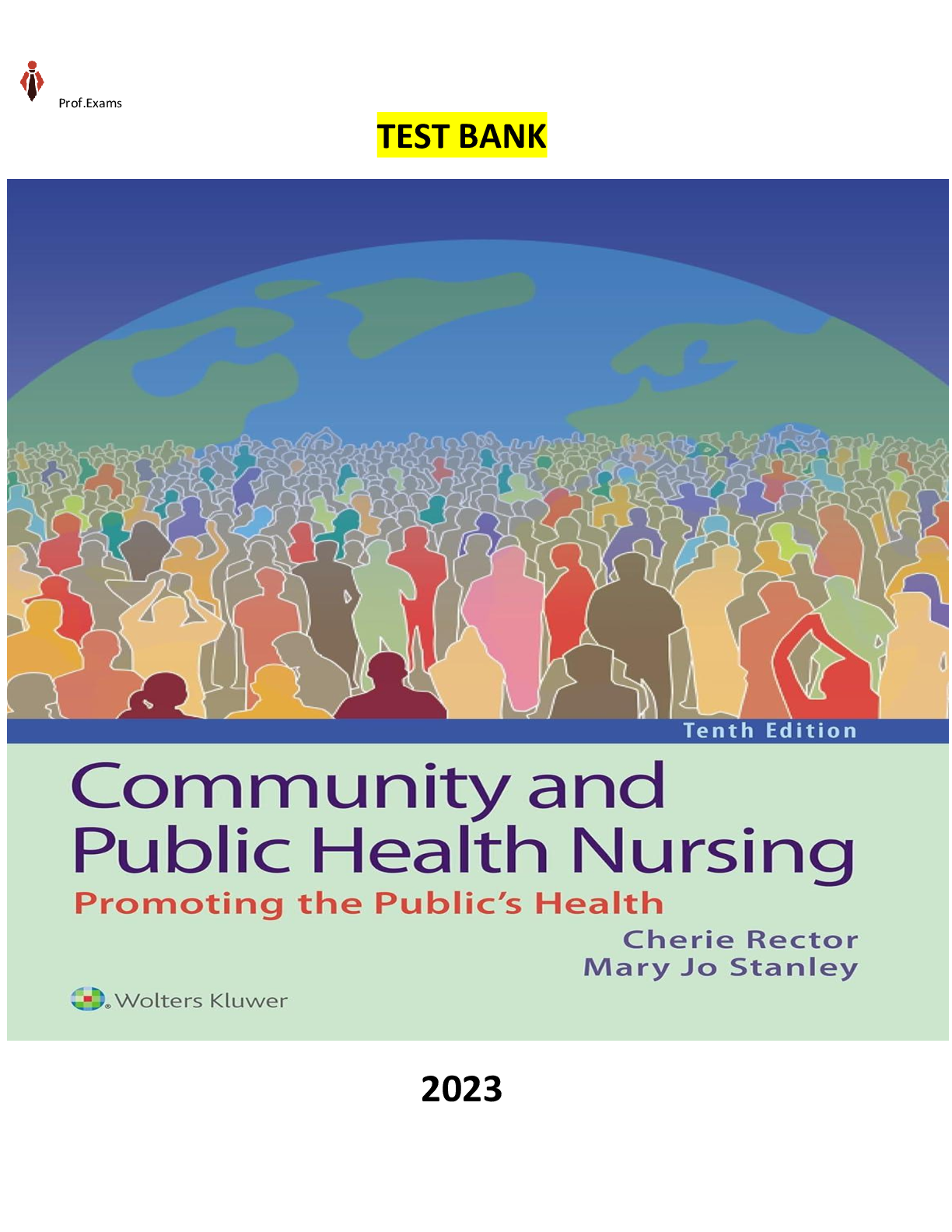


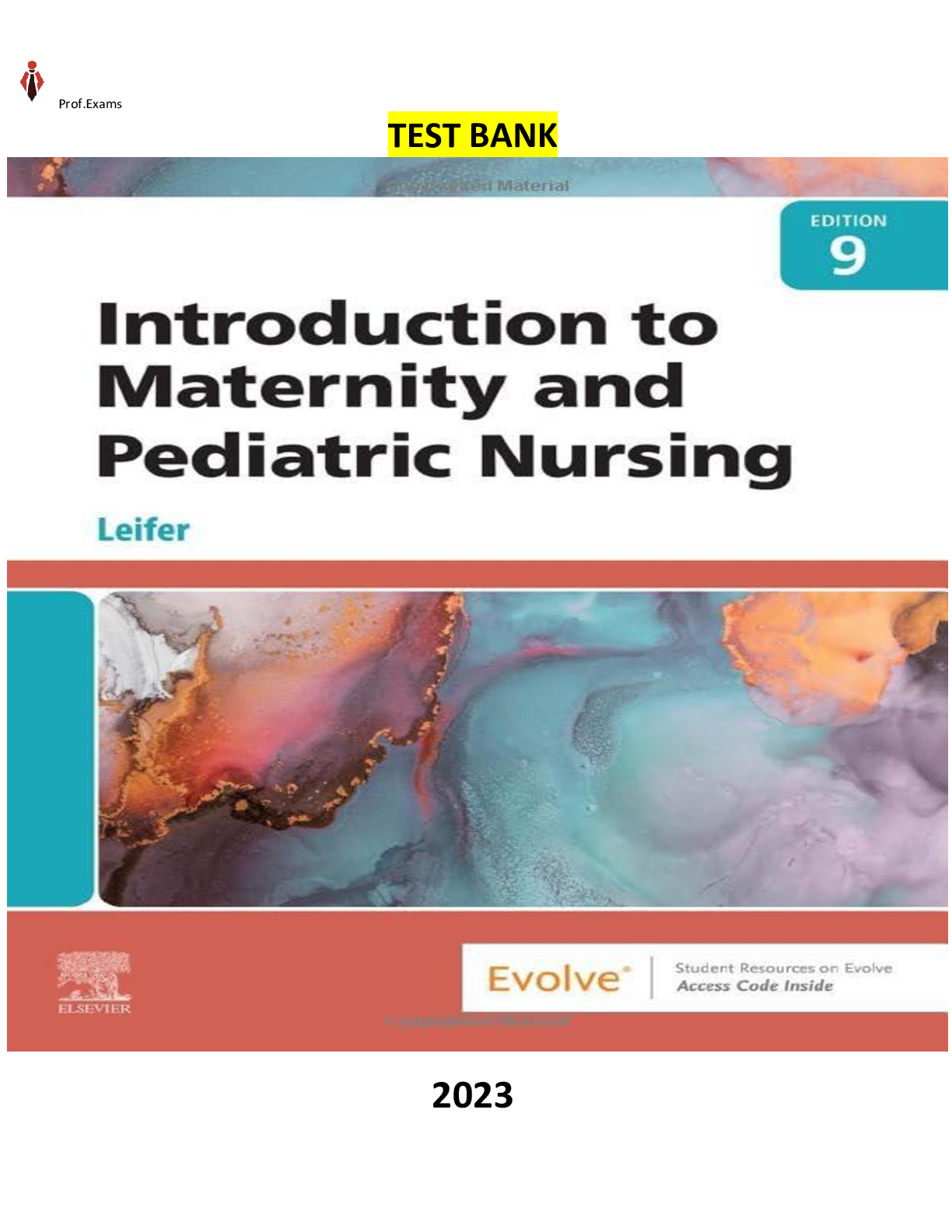
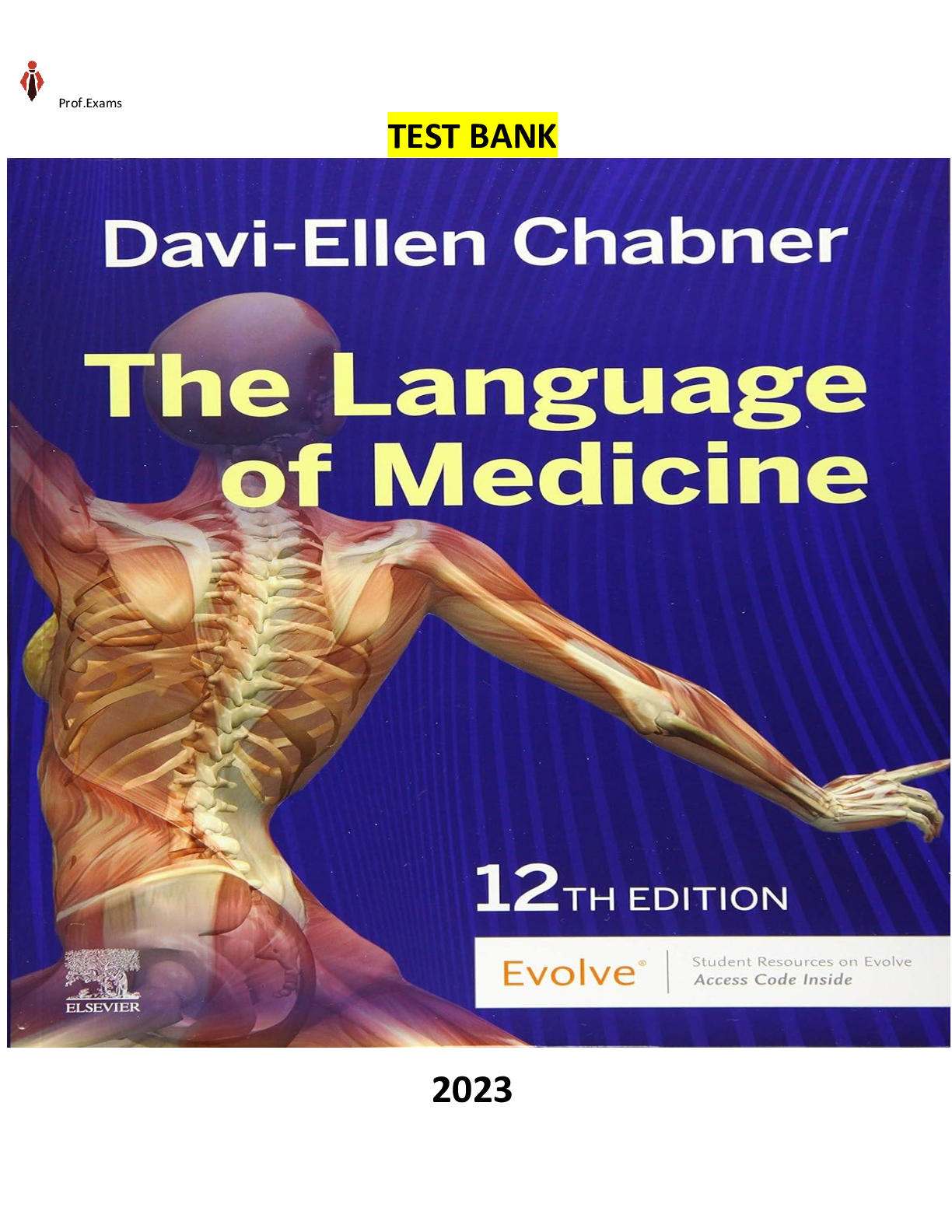
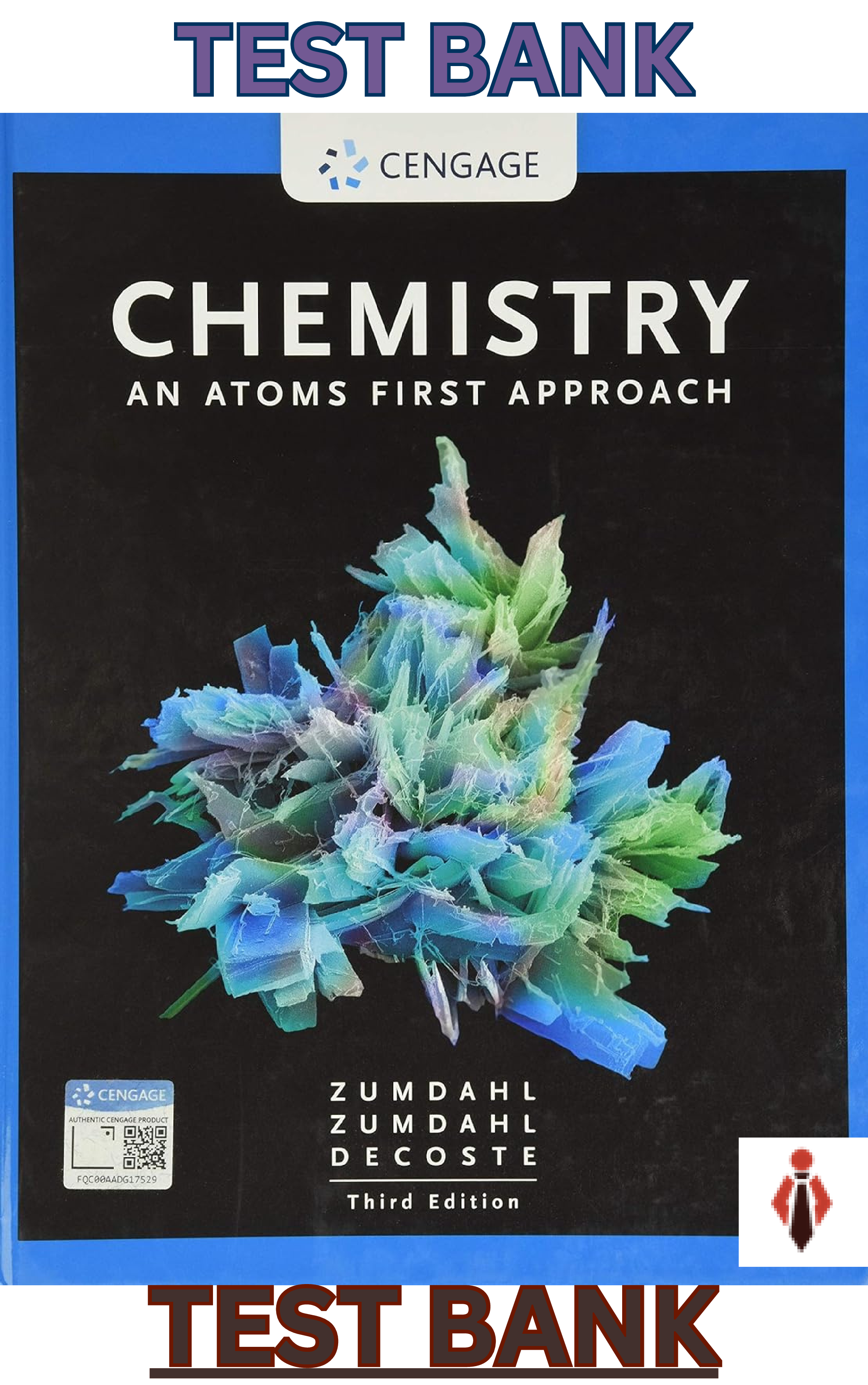

.png)

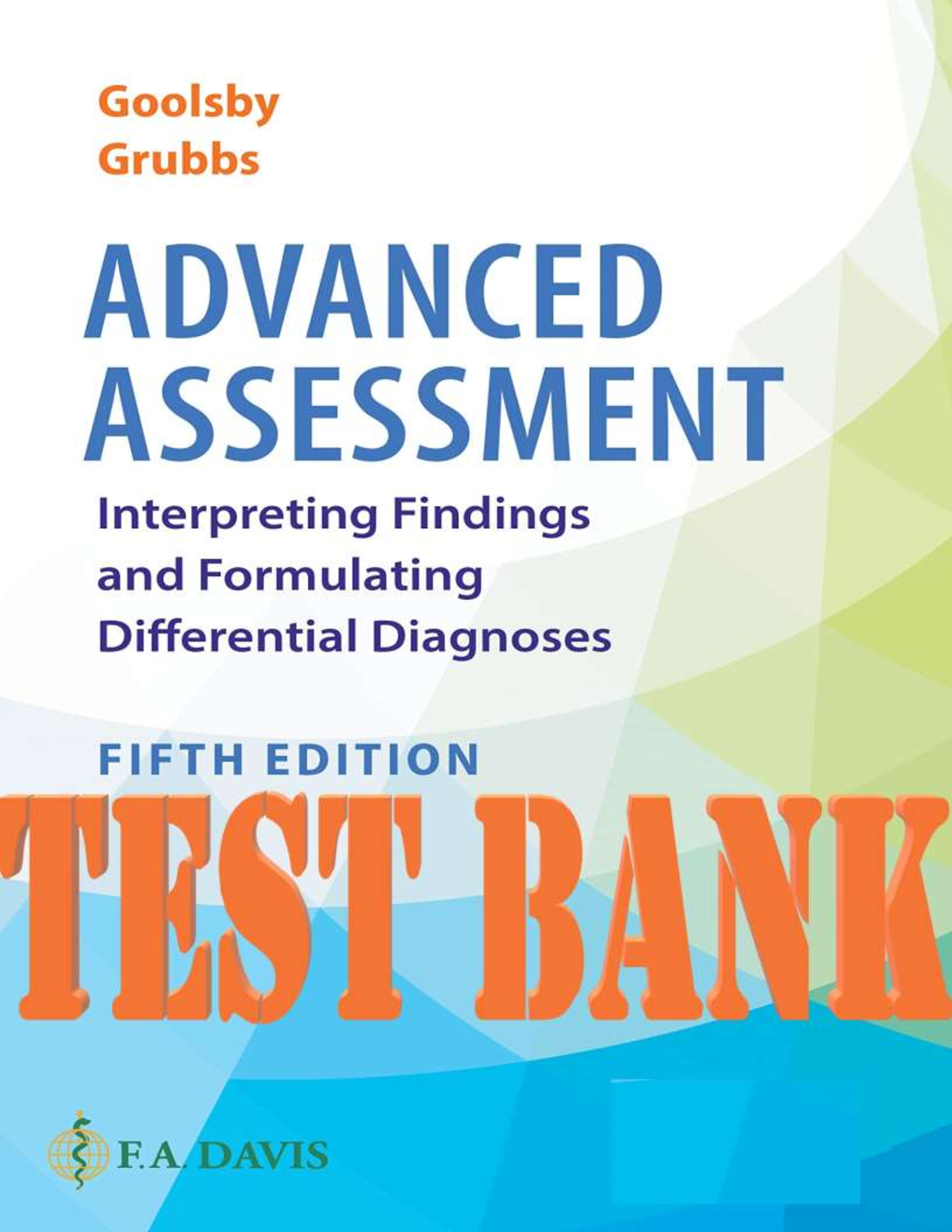
.png)
